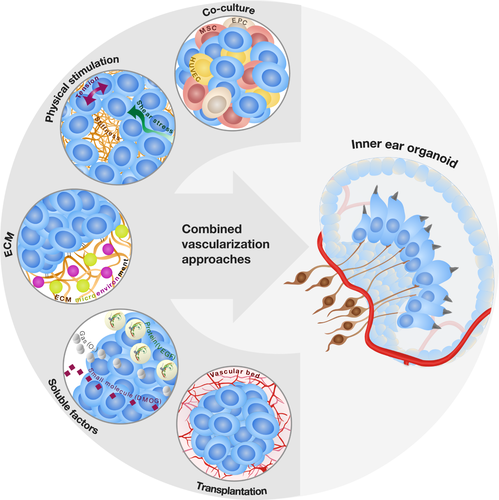
Seattle Genova provides various organoids which act as a promising modeling tool for advanced studies in multiple aspects of different organs and aim for the development of new treatments and validation of drug-based therapies. Similarly, we also provide services for inner ear organoids to understand the blood supply and corresponding pivot role in the maturation, growth, and survival of inner ear tissues and their physiological functions. Our inner ear three-dimensional organoids provide a route for novel and improved various hearing loss treatments.
Seattle Genova Services
Seattle Genova offers a truly in vivo-like inner ear model which mimics the microenvironment and niches of the organ. Our services also offer three-dimensional inner ear organoids and generate in vitro vasculature of inner ear models.

Fig: possible methods for the vascularization of inner ear organoids (Moeinvaziri et al., 2021).
Inner Ear Organoids from Embryonic Stem Cells
Seattle Genova develops human inner ear organoids from embryonic stem cells leading to the successful generation of optic placode on the surface of aggregates. The aggregates on the end of differentiation, produce an epithelium containing functional vestibular hair cells with various supporting cells which are innervated by sensory neurons. Hence, our services produce an epithelium that contains functional vestibular hair cells containing cochlear hair cells.
Inner Ear Organoids from Pluripotent Stem Cells
Another inner ear organoid our services offer is extracted from pluripotent stem cells and cochlear organoids generated from the tissue-specific progenitors. Our cochlear organoids developed from murine Lgr5-positive cochlear supporting cells by isolating cells from early postnatal mice.
Inner Ear Organoids from Fetal Sensory Cells
The inner ear organoids develop from human fetal pro-sensory domain cells through the disassociation of the whole cochlea into a unicellular or single-cell suspension and sorting of the cell with a combination of the surface markers. The next step is to aggregate the cells in round bottom 96-well plates and embedded in Matrigel.
Inner Ear Organoids from Mesenchymal Cells
Another differentiation is through coculture with mesenchymal/ neuronal progenitor leading to the development of supporting cells and hair cells which had epithelial organization and hair cells for inner ear organoids.
Importance of Inner Ear Organoids
Our inner ear organoids are a potent source of improvement for the production of more complex organoids by allowing the transport of oxygen and nutrients. Moreover, these inner ear vascularized organoids can be modeled for drug delivery and affect the maturation of inner ear organoid systems.
References
Moeinvaziri, F., Zarkesh, I., Pooyan, P., Nunez, D. A., & Baharvand, H. (2021). Inner ear organoids: progress and outlook, with a focus on the vascularization. The FEBS Journal.
Thank you for your interest in our Inner Ear Organoid Culture Service services. Please complete the form below and we will contact you shortly.
Fields indicated by an * are required.